As we enter the month of May, Mary stands before us as our mother and the Mother of the Church. She truly is our mother, given to us by Jesus at the foot of the cross. It is well for us to reflect upon Mary as our mother as we reflect upon her as the mother of Jesus. A beautiful, simple but profound poem/prayer is that of Mary Dixon Thayer, “To Our Lady.” She wrote many poems, but this one is a very well-known one about the motherhood of Mary, with which some of us may be very familiar from our earliest days. This poem was often used by Archbishop Fulton J. Sheen, especially at the closing of his famous weekly TV presentations. The poem is:
Lovely Lady dressed in blue
Teach me how to pray!
God was just your little boy,
Tell me what to say!
Did you lift Him up, sometimes,
Gently on your knee?
Did you sing to Him the way
Mother does to me?
Did you hold His hand at night?
Did you ever try
Telling stories of the world?
O! And did He cry?
Do you really think He cares
If I tell Him things
Little things that happen? And
Do the Angels’ wings
Make a noise? And can He hear
Me if I speak low?
Does He understand me now?
Tell me — for you know.
Lovely Lady dressed in blue
Teach me how to pray!
God was just your little boy,
And you know the way.
This poem was frequently used by young children making their first Communion, sometimes with a presentation of flowers to a statue of the Blessed Mother after the reception of Communion. May is a fitting month, as so many of our children make their first Communion, to reflect upon Mary and her relationship to the Eucharist. Indeed, Mary does teach us, as she did Jesus, how to pray, and especially in His most central prayer of the Eucharist. Mary has an intimate relationship with the Eucharist.
Mary is the perfect disciple of Christ, the one who first shared the effects of Christ’s Redemption in all of their richness. She also stands before us as the perfect human person with whom we can identify in the many aspects of our pilgrimage through life. She knew the same successes and failures, joys and sorrows, pleasures and pains that are part of our lives, and perhaps even more so. Though free from sin, she was completely human, and for that reason the Lord entrusted her to us as our mother and the Mother of the Church. That is why we can go to Mary in prayer, confident that she, who bore the Son of God in her virgin womb, was quite familiar with our daily existence. As a human being, mother and friend, she truly knows the way and tells us what to say.
In his encyclical on the Eucharist, Ecclesia de Eucharistia, St. Pope John Paul II wrote of the profound relationship which Mary has with the Eucharist. He stated that, while the account of the institution of the Eucharist at the Last Supper makes no mention of Mary, we know that she was present among the apostles who prayed with one accord (cf. Acts 1:14) and must have been present at the Eucharistic celebrations of the first Christians, who were devoted to the breaking of bread (cf. Acts 2:42).
Mary’s role as the perfect disciple is first seen as she accepted unconditionally the will of God by allowing herself to become the Mother of God’s Son. At the Annunciation, Mary’s words, “May it be done to me according to your word” (Lk 1:38), allowed the physical reality of Christ’s Body and Blood to become present in her womb. Her words of complete faith are echoed in the “Amen” we say when we receive the Body and Blood of the Lord in the Eucharist. In conformity with Mary’s faith, we profess our belief in the Eucharist that the same Jesus Christ, Son of God and Son of Mary, becomes present in His full humanity and divinity under the appearance of bread and wine. Mary knows the way and tells us what to say.
The Eucharist is a mystery of faith which calls for complete abandonment to the Word of God. There can be no one like Mary as our guide in acquiring this disposition of abandonment. In repeating what Christ did at the Last Supper in obedience to the Lord’s command, “Do this in memory of me,” we also accept Mary’s invitation at the wedding feast of Cana, “Do whatever He tells you” (Jn 2:5). St. Pope John Paul II told us, “With the same maternal concern which she showed at the wedding feast of Cana, Mary seems to say to us, ‘Do not waiver, trust in the words of my son. If He was able to change water into wine, he can also turn bread and wine into His Body and Blood, and through this mystery bestow on believers the living memorial of His Passover, thus becoming the ‘bread of life.’’” Again, Mary knows the way and tells us what to say.
St. Pope John Paul II used to often remind us that the Body and Blood of the Lord, which become present at Mass, are the same Body and Blood conceived in the womb of Mary. He reflected, “What must Mary have felt as she heard from the mouth of Peter, John, James and the other apostles, the words spoken at the Last Supper: ‘This is my Body which is given for you (Lk 22:19)?’” Mary is present at every Mass in a unique way since the Body and Blood of Christ is that derived from the body and blood of Mary.
Indeed, the gift of Mary and the gift of the Eucharist are intimately bound together in the life of the Church. In our pilgrimage through this life, which is fed by the Eucharist, Mary stands before us as a model. She was a “woman of the Eucharist” throughout her whole life. She held the Son of God in her womb and in her hands. Like all of us, she knew the joys and tribulations of our human existence. Her Son is “the way, the truth, and the life” (Jn 14:6), who gives meaning to human existence. His presence in the Eucharist is truly the way, and to that way Mary points. “Lovely Lady dressed in blue — Teach me how to pray!” The faith and innocence of first Communicants do have much to teach all of us. Mary knows the way and tells us what to say.
Most Reverend Gerald M. Barbarito
April 28, 2023

